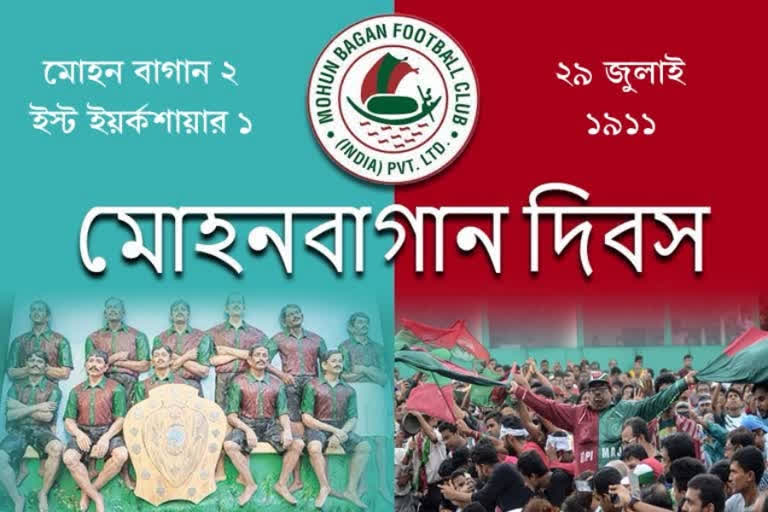Kolkata: On July 29, 1911, Mohun Bagan, the legendary football club from Kolkata defeated the British East Yorkshire club and bagged the IFA Shield as India's first soccer club. Indirectly, it was the first taste of defeat for the Britishers in pre-independence India. The people of Kolkata, then Calcutta, were quite excited over that IFA Shield final match played on that day.
There were no galleries for the spectators during that period. The spectators were watching the match sitting or standing beside the playground. People from different parts of the then undivided Bengal came to Kolkata to be witnesses of that historical match. The crowd was quite impressive and some of those falling back in the rush had hired periscopes to watch the tussle. The rent per periscope was Rs 2, quite an impressive amount then. After every goal, the spectators far away were informed about it through kites.
Mohun Bagan's victory in that match on July 29 was not necessarily the first success of any Indian football club against any British team. The Kumartuli Club and Sovabajar Club defeated English teams in the Trades Cup. Although Mohun Bagan won the Gladston Cup in Cinsurah, the victory on July 29, 1911, was in a true sense the victory of the Indians against the British.
The current generation knows Yorkshire as the hub of Sachin Tendulkar's first County Club. Yorkshire is also known for legendary British cricketers like Geoffrey Boycott and Len Hutton. But for Kolkata football, Yorkshire remains a symbol of the victory of 11 Bengalis against a dominant British team. Lots of myths are still associated with that day.
Also Read: Nationalism model flops, BJP to rake up local issues in Bengal
After that historical match, the members of the winning Mohun Bagan team were passing by the tent of the Customs Club. The destination was Sen House located at the current Mohun Bagan Lane, where the club started its journey. People were rushing to congratulate them. Suddenly, one Brahmin priest approached Sudhir Chattopadhyay, a team member, and asked him a question. “You have defeated the British football team. When will the Union Jack be pulled down from the top of Calcutta High Court?” the Brahmin priest asked.
"The day Mohun Bagan will be the winner in Calcutta Football League, on that very day the Union Jack will be pulled down," replied Chattopadhyay. Coincidentally, Mohun Bagan emerged as the league champion in 1947.
The full-back of the winning team, Bhuti Sukul, took a leave from his office of Calcutta Municipal Corporation on that day. He gave a fake excuse for the leave to his British boss, Mr Madax. However, his lies were caught as Mr Madax came to watch the match. The boss and the subordinate did not interact there. However, Sukul got scared of losing his job.
Also Read: NHRC report: HC allows Bengal govt to file supplementary affidavits
The next day, he went to the office with his resignation letter. His boss summoned him to his room to congratulate him and awarded him with flowers and gifts. A portrait of Sukul is still there at the entry of Calcutta Municipal Corporation, which is now Kolkata Municipal Corporation. The bench that was used by the winning team on that day is still preserved at the club tent. It was not just football. Rather it was a truly national movement, which mesmerized the East Yorkshire team members.
Generally, it rains during July in Bengal. But on that day as well as during the seven days before that there were no rains. The field was dry and hence the barefooted Bengali players could challenge the football boot sporting British players. Then, the logo of the club was a resting tiger under a mango tree. Rajen Mullick ordered 12 special medals with that logo for the winning team members. The 12th medal was one of the brightest Indian players of the coming days, Gostha Pal.
Mohun Bagan's historic victory united the Indians on that day. The people started dreaming of freeing undivided India from British rule more forcefully since then. That factor is still relevant. This year legendary goalkeeper Shibaji Banerjee has received the Mohun Bagan Ratna (posthumous) award. Roy Krishna has been selected as the best footballer. Abhimanyu Easwaran has been selected as the best cricketer. Bidisha Kundu has been selected as the best athlete. Such awards still recall the pride of that day.
Also Read: Raj Kundra's connections slip into Kolkata, illegal guesthouses turn hotbeds of crime


